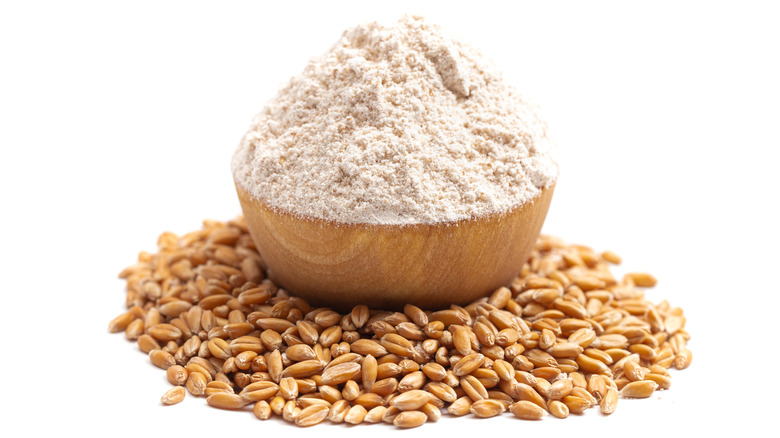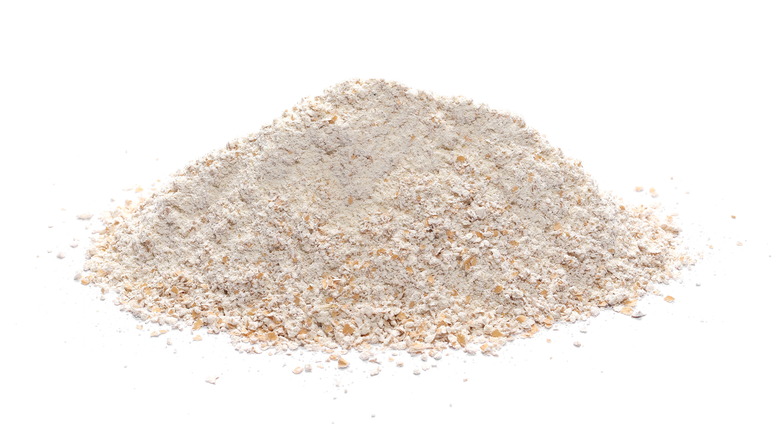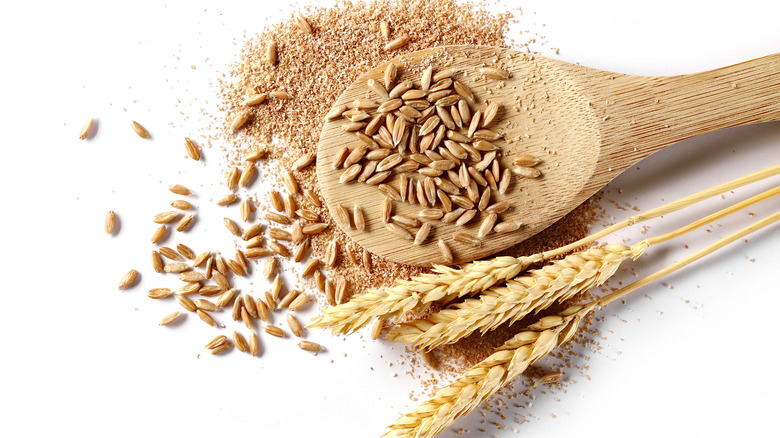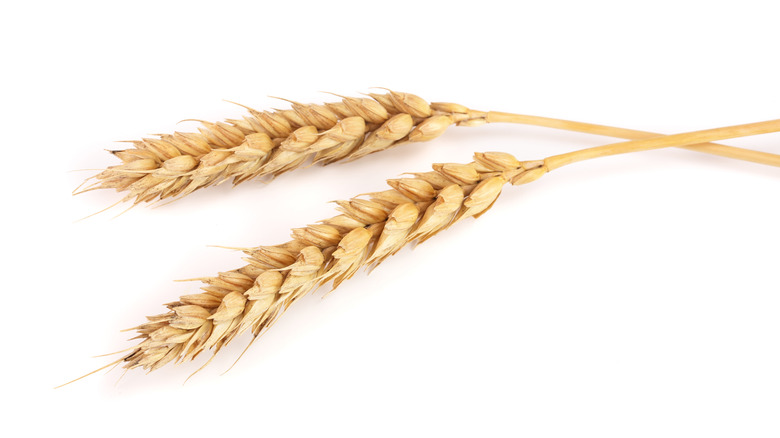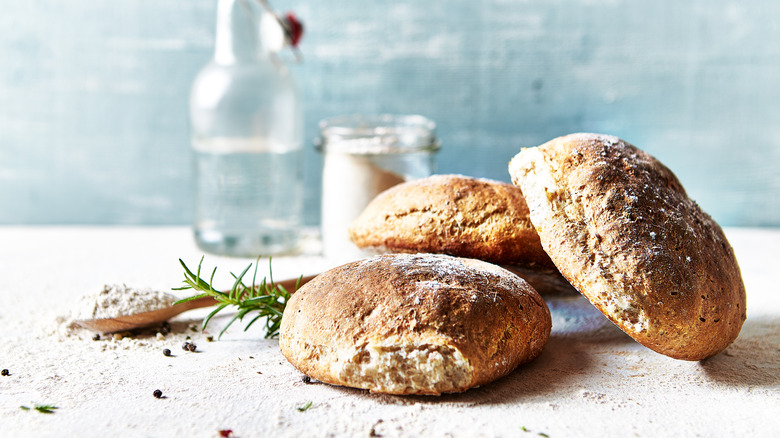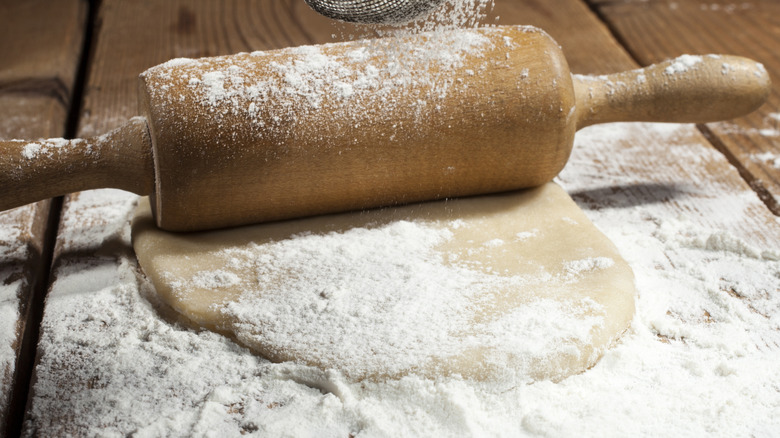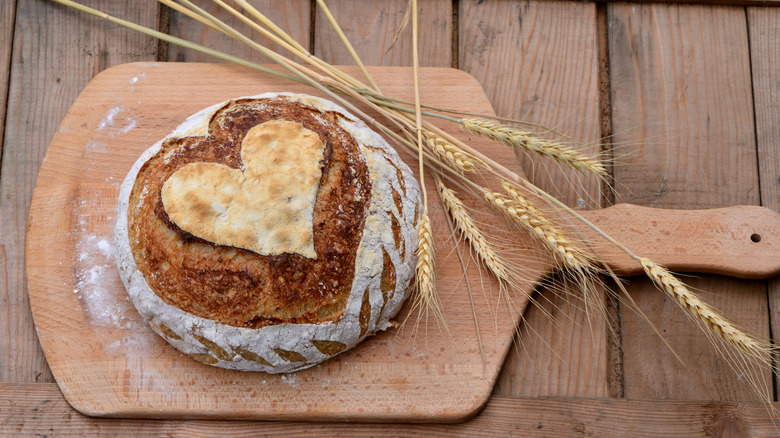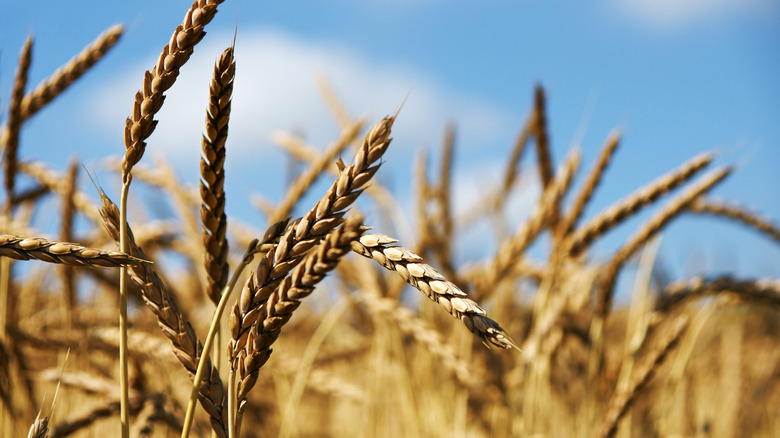What Is Spelt Flour And Is It Gluten-Free?
Some of the world's most ancient grains are returning to the market in full force. As people learn more about nutrition, allergies, and the wide range of available options, trying new foods becomes the obvious next step. Wheat flour has always been a mainstay of the American diet, but increasingly, issues such as gluten intolerance mean that people are searching for other options. Spelt (Triticum spelta) has been around since 5000 B.C. and is one of wheat's ancestors (via MasterClass). The Greeks believed it was an offering from the goddess of harvest, making it a highly important crop at the time, Bob's Red Mill explains.
The source notes that the history of spelt in the United States is much younger, because the grain was quickly swapped out for wheat in the early 1900s. Although spelt is not a gluten-free alternative to wheat since it is from the same family, spelt has some health advantages in that it is a little easier to digest than wheat for people with IBS. Whether you opt for spelt flour as a nutritious addition to your diet or simply because of its pleasant flavor, you will surely enjoy having some variety.
What is spelt flour?
Spelt (also known as dinkel or hulled wheat) belongs to the Poaceae family and is understood to be an ancestor of wheat as we know it (via Britannica). Healthline adds that barley and rye are other relatives. Spelt has traveled around the world, originating in Iran and making its way to central and southern Europe, as well as Spain, according to AncientGrains. In the USA, spelt production is mainly concentrated in Ohio, although the grain is quite hardy and can successfully grow in cooler climates.
The grain is slightly reddish and has a similar shape to barley. Unlike wheat, the seed has a hard outer shell which slows down processing time but allows a greater amount of nutrients to be retained, as noted by Healthline. People with a minor gluten intolerance are more likely to be able to digest spelt thanks to the breakdown of its gluten content. One Green Planet specifies that gluten is a protein composed of gliadin and glutenin, the former of which provide stretchiness and the latter elasticity and structure. Contrary to wheat, spelt contains a greater proportion of gliadin which breaks down in water. This characteristic ultimately makes it easier to digest. Nevertheless, anyone with celiac disease or a serious gluten allergy should steer clear.
How is spelt flour made?
Once spelt grains have been harvested and sorted for quality, the flour is produced through a milling process. Healthy Hildegard explains that the entire grain is ground, sifted, and blended based on the desired texture. A traditional method of stone milling is most often used for spelt. Since the entire grain is ground up into flour, whole grain spelt flour does not require added enrichment because the nutrients are not lost in processing. Visually, the flour is a pale brown color due to the inclusion of the outer shell. Since there's no need to dehull the grain, VeryWellFit points out that you can even make your own spelt flour by adding the grains to a food processor or grinder.
On the other hand, Bon Appétit notes, white spelt flour is another product made from the same grain. In this case, the outer bran and germ of the seed are removed before milling, ultimately creating a finer, paler flour. While the result is more similar to all-purpose flour, the process to remove the hard outer shell is trickier than it is with wheat. For this reason, the production of white wheat flour quickly became more desirable for manufacturers.
Spelt flour vs. wheat flour
The major difference between spelt and wheat flour is that the two are made from distinct grains. Although they belong to the same family, they each have unique properties. According to Healthy Hildegard, the spelt grain consists of a hard outer shell that helps retain nutrients but is also more tedious to process into flour. Wheat is usually processed without its surrounding shell, reducing the overall nutritional value of the flour. Furthermore, wheat flour is regularly bleached to produce a bright white result, according to Foods Guy.
Aside from their processing methods, the two grains also differ in terms of gluten content, according to Healthline. Spelt flour has less gluten and its structure is slightly easier to digest. Nutritionally, spelt has far more fiber and a bit more protein compared to wheat flour. Since wheat is stripped of all its nutrients during processing, it is usually enriched in order to provide some benefits to the consumer. Finally, although spelt is pleasantly subtle, Bon Appétit says it also has a nutty sweet flavor that sets it apart from plain wheat flour.
What does spelt flour taste like?
Spelt flour is an easy wheat flour alternative to experiment with because the flavor is not as overpowering as other options such as dark rye. This ancient grain has a mildly nutty and sweet flavor (via Bon Appétit) that makes it a great option for savory or sweet baked goods. Additionally, an underlying tanginess can be tasted, especially if you use it as a base for sourdough bread. While it won't dominate the flavor profile, it has a noticeable quality that makes it distinct from wheat.
Bon Appétit says that the whole grain variety has an earthier taste since the outer shell is milled into the flour, whereas white spelt flour is subtler. The flavor distinction between the two is similar to whole wheat flour compared with regular white flour. If you are wary of novel flavors, then start by using white spelt flour since it is more delicate than the whole grain variety.
How to cook with spelt flour
Spelt flour still contains gluten, so you won't need to significantly adapt recipes to be successful. Baking Bites indicates that substituting regular flour at a one-to-one ratio is fine. Ideally, use whole grain spelt flour in place of whole wheat and white spelt flour instead of all-purpose. If you are replacing regular wheat flour with whole grain spelt, Bob's Red Mill recommends first only substituting a quarter to a half of the flour to ensure that the texture holds up.
The grain itself can be cooked much like barley, however, spelt flour is often a component of baked goods. Bread, muffins, cookies, cakes, scones, waffles, and the like will benefit from the mildly nutty and sweet flavors of spelt. Thanks to the lower gluten content, baked goods made with spelt tend to have a light, airy, and tender texture.
For the most part, spelt flour behaves similarly to wheat, however, One Green Planet explains a lower liquid content is required in recipes since spelt flour is more water soluble. The source also recommends adjusting recipes by adding more yeast or baking powder, since spelt flour doesn't rise as high due to its gluten composition. Finally, avoid over-kneading or over-mixing the dough because the gluten content of spelt makes its structure fragile and susceptible to crumbling if overworked.
Where to buy spelt flour
Thanks to a high level of interest in wheat flour alternatives, spelt flour is increasingly available in supermarkets. Although it isn't gluten-free, it can be shelved near these products. Depending on the store, you might find it together with other flours and baking ingredients or else in the natural food aisle, since it is commonly used in healthy preparations. Similarly, health food stores should carry spelt flour since it is considered to have some beneficial nutritional properties. You can't go wrong with whole grain retailer Bob's Red Mill, which sells quality spelt flour in stores and online. If you don't have access to a large variety at your local stores, an online search will bring up plenty of options for purchase.
Keep in mind that you might have the option of either whole grain or white spelt flour. For maximum flavor and nutrients, pick whole grain. If you want to be involved in the processing step, buy whole spelt grains and grind them yourself. To keep the flour at its freshest, Bob's Red Mill recommends storing it in the refrigerator or freezer in an airtight container once you have opened the package.
Nutritional information about spelt flour
Nutritionally speaking, spelt is a good flour option because plenty of nutrients are retained during its processing. This results in a high fiber content which according to Healthline, can assist the body by slowing down digestion and minimizing sudden increases in blood sugar. The source also notes that obesity, heart disease, and type 2 diabetes risks may be decreased with a diet high in fiber. The flour has about five grams of protein per quarter cup and close to no fat. If you're seeking variety in your baked goods, spelt will add both flavor and nutrients.
The seed also has high levels of manganese, phosphorus, niacin, magnesium, iron, zinc, and calcium (via Healthline). As with many plant foods, Healthline explains that spelt contains anti-nutrients which can block the absorption of important vitamins and nutrients. However, as long as you maintain a diverse diet, the effects shouldn't be an issue. Anyone with a gluten allergy should avoid spelt flour since it contains significant gluten. However, Healthline points out spelt could be a suitable alternative for some people suffering from irritable bowel syndrome and follow a FODMAP diet. If you have digestive issues related to wheat, you should speak to your doctor before incorporating spelt into your diet since it is a wheat product.
Other varieties of spelt flour
As explained in the processing method, the two varieties of spelt flour are whole grain or white (via Masterclass). Whole grain is produced with the bran and germ intact, resulting in a coarser flour high in nutrients. Per Bon Appétit, white spelt flour is made from the grain after it has been stripped of the bran and germ, producing a fine white flour that is far more similar to regular all-purpose. If you're looking for a unique flavor, whole grain is undoubtedly a better choice. However, if you want the spelt flour to have minimal impact on the final taste, a white flour variety is more suitable.
Nutritionally the two flours are distinct since whole grain spelt flour benefits from all of the nutrients from the outer shell which is eliminated to make the white variety. However, VeryWellFit cautions, the whole grain variety does not always match up as an exact substitution if you are using it in place of all-purpose flour. For baked goods such as cakes which require a proper rise, stick to using recipes developed for this type of flour.
